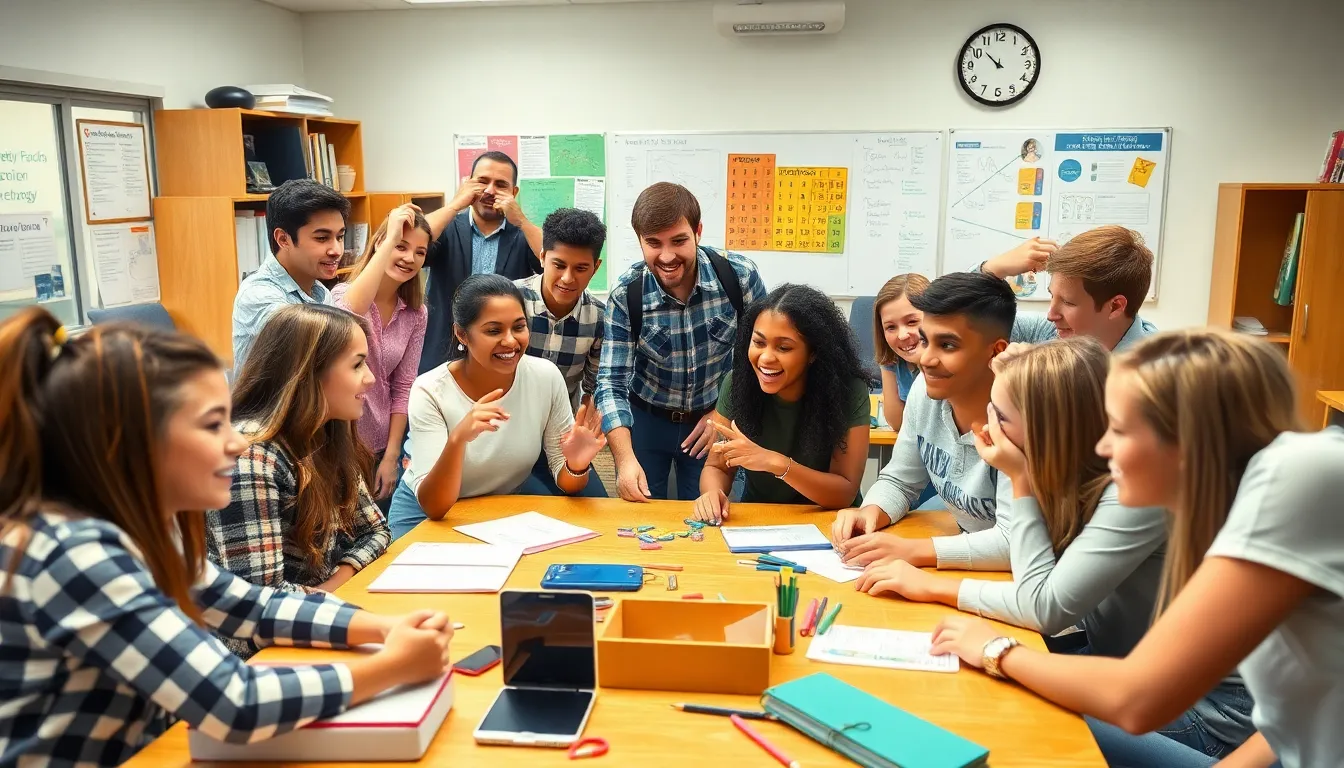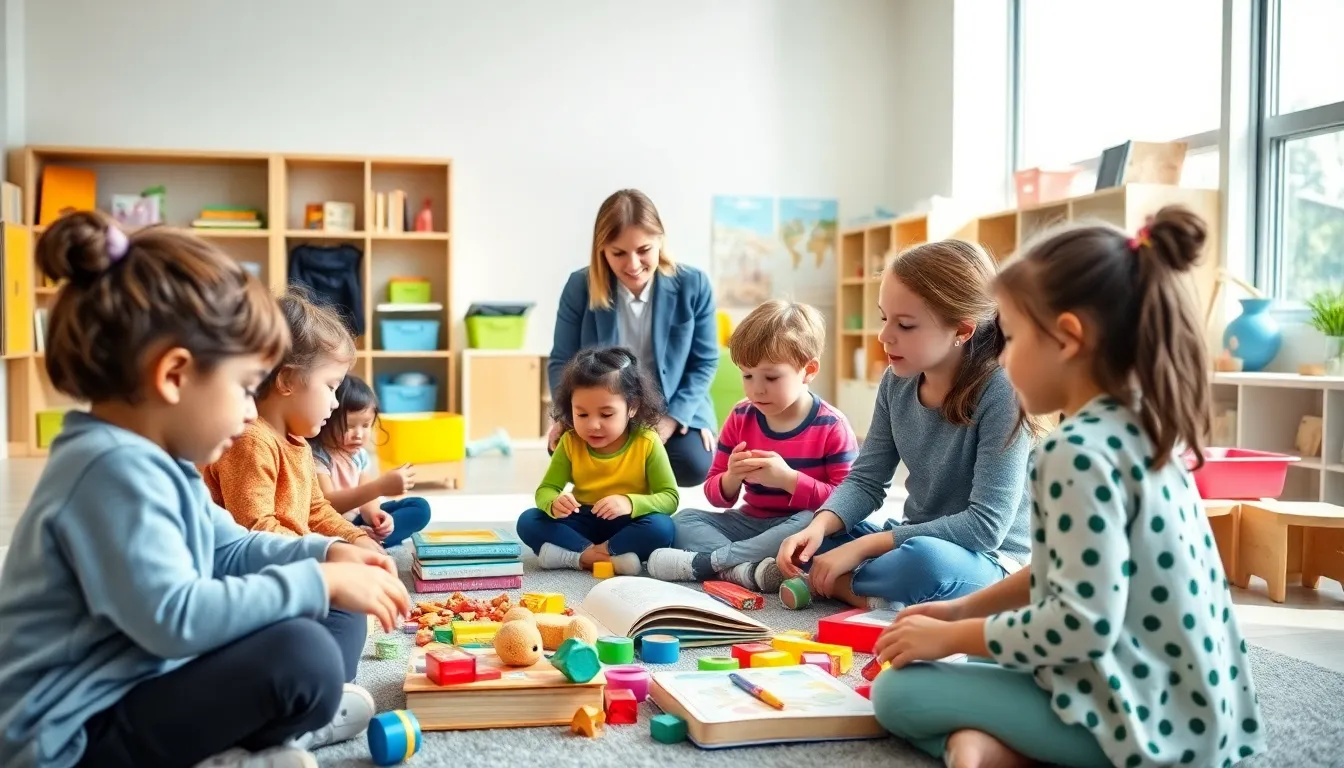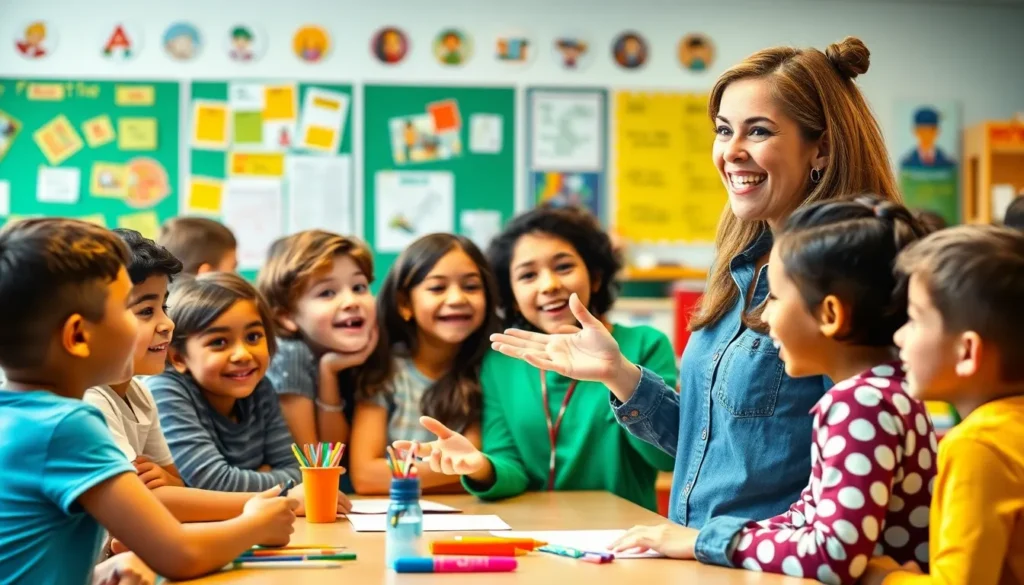Table of Contents
ToggleIn a world where language can feel as daunting as a three-headed dragon, creative language teaching swoops in like a heroic knight. It transforms the mundane into the magical, turning vocabulary drills into vibrant adventures. Imagine students not just memorizing words but engaging in lively storytelling, role-playing, and even crafting their own songs.
This approach not only makes learning fun but also sparks genuine interest. When students laugh while they learn, they’re more likely to remember those tricky grammar rules and expand their vocabulary. So, why settle for boring textbooks when creativity can unlock the door to fluency? Get ready to explore how innovative techniques can breathe life into language learning and inspire students to become confident communicators.
Overview of Creative Language Teaching
Creative language teaching focuses on transforming traditional educational practices into engaging experiences. Techniques like storytelling ignite imagination, drawing students into narratives that enhance their connection with language. Role-playing offers another dynamic, allowing for immersive practice that develops fluency and confidence.
Activities like songwriting not only stimulate creativity but also aid in vocabulary retention. By incorporating rhythm and melody, learners experience language in a multifaceted way, reinforcing grammar through context. Conventional textbooks may limit engagement, but innovative approaches empower students to take control of their learning journey.
Utilizing art and technology further enriches the learning environment. Digital tools facilitate interaction, encouraging collaboration among students. Visual aids can also connect language to real-world scenarios, making lessons more relatable and impactful.
Creative language teaching fosters a supportive atmosphere where students feel comfortable expressing themselves. This environment nurtures risk-taking, essential for mastering new languages.
By prioritizing enjoyment alongside education, practitioners cultivate lifelong learners who eagerly explore linguistic depths. Engaging activities create memorable lessons, ensuring that language skills are not just learned but appreciated. Emphasizing creativity effectively enhances both comprehension and retention, leading to more successful outcomes in language acquisition.
Principles of Creative Language Teaching

Creative language teaching emphasizes engaging students actively in the learning process. Such approaches prioritize enjoyment, helping to develop a passion for language.
Encouraging Student Engagement
Engagement stems from interactive activities that spark interest. Storytelling captivates students, allowing them to visualize language in context. Role-playing immerses learners in real-life scenarios, encouraging them to practice conversational skills. Incorporating games keeps energy high while reinforcing grammar and vocabulary. Furthermore, using technology in lessons facilitates collaboration and interaction among peers. When students work together on projects, they build confidence and deepen their understanding. Engaged learners retain information better, leading to improved communication abilities.
Fostering Critical Thinking
Critical thinking emerges through creative problem-solving activities. Language games challenge students to think on their feet, promoting flexibility in communication. Analyzing texts encourages deeper comprehension, as students explore themes, characters, and contexts. Moreover, songwriting invites learners to express ideas uniquely, enhancing both creativity and analytical skills. Students navigate grammatical structures consciously while crafting lyrics. Emphasizing these experiences cultivates an environment where critical thinking thrives, ultimately enriching language proficiency. Learners grow more adept at interpreting language nuances, equipping them for various communicative scenarios.
Techniques for Implementing Creative Language Teaching
Creative language teaching employs various techniques that enhance engagement and facilitate learning. Innovative approaches capture student interest while fostering effective communication.
Interactive Activities
Interactive activities play a crucial role in creative language teaching. Games, simulations, and role-plays immerse students in realistic scenarios, encouraging spontaneous language use. Techniques like group discussions promote collaboration and enable learners to express thoughts. Through these activities, vocabulary acquisition and grammar application occur in relevant contexts. Engaging exercises like debates and storytelling sessions ignite creativity while improving fluency. This structured approach enhances confidence, making learners more comfortable using the language in real-world situations.
Multimodal Resources
Multimodal resources significantly enrich the language learning experience. Incorporating visuals, audio, and kinesthetic materials caters to diverse learning styles. For example, videos and podcasts reinforce comprehension while adding context to vocabulary lessons. Artwork and graphic organizers assist in visualizing complex concepts. Utilizing digital tools encourages collaboration, enabling students to share creations and insights. Such resources create an engaging atmosphere where learners interact meaningfully. This integration of various modalities not only deepens understanding but also equips students with essential skills for effective communication.
Benefits of Creative Language Teaching
Creative language teaching enhances various aspects of learning, primarily through engaging methods that capture students’ interests. Distinct approaches can lead to impressive results in language acquisition.
Enhanced Language Skills
Creative language teaching promotes improved language skills through interactive activities. Storytelling encourages students to practice vocabulary and grammar in context, reinforcing understanding and retention. Role-playing immerses learners in real-life scenarios, enabling them to develop fluency and confidence in speaking. Additionally, songwriting combines rhythm with language learning, which aids in memorization of new words and structures. Students engage with diverse materials, such as visuals and audio, catering to various learning styles. This multi-faceted approach ensures all learners grasp language concepts effectively.
Increased Motivation
Creative techniques significantly boost motivation among language learners. Engaging tasks, like games and role-plays, make lessons enjoyable and foster a positive mindset toward language learning. When students feel excited about activities, they’re more likely to participate and take risks without fear of failure. Collaborative group discussions enhance both communication skills and social interaction, reinforcing their interest in learning. Furthermore, the use of technology provides dynamic resources that intrigue learners. This blend of enjoyment and engagement cultivates a vibrant classroom environment where students thrive.
Challenges in Creative Language Teaching
Creative language teaching faces several challenges that educators must navigate to enhance student learning. These obstacles can impact the effectiveness of innovative strategies.
Addressing Diverse Learning Styles
Addressing diverse learning styles proves crucial in creative language teaching. Recognizing that students absorb information differently emphasizes the need to incorporate varied instructional methods. Visual aids, auditory resources, and kinesthetic activities engage different learners, enhancing comprehension. Tailoring activities to meet specific preferences helps ensure that all students actively participate. Group work fosters collaboration, allowing learners to share insights and perspectives, reinforcing their understanding. Ultimately, adapting to diverse styles creates a more inclusive environment that supports effective language acquisition.
Balancing Creativity and Structure
Balancing creativity and structure presents another challenge in creative language teaching. While creativity enriches the learning experience, establishing clear objectives remains necessary. Without a structured approach, students may struggle to grasp essential language concepts. Integrating creative activities within a well-defined framework ensures that learning goals are met. Structured lesson plans provide guidance, allowing for spontaneous moments of creativity without losing focus. This balance cultivates an engaging atmosphere while ensuring that students achieve fluency and proficiency. Effective educators continuously assess and adapt their approaches to maintain this equilibrium in their teaching methods.
Creative language teaching reshapes the educational landscape by prioritizing engagement and enjoyment. By integrating innovative techniques like storytelling and role-playing, educators not only capture students’ imaginations but also enhance their language skills. This approach cultivates a supportive learning environment where students feel empowered to express themselves and take risks.
Balancing creativity with structured learning ensures that essential language concepts are mastered while fostering critical thinking. As educators embrace these dynamic methods, they pave the way for lifelong learners who appreciate the beauty of language. Ultimately, creative language teaching transforms language acquisition into an exciting journey, enriching both personal and academic growth.







